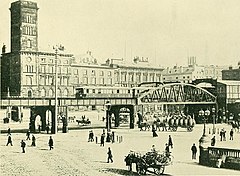Liverpool Overhead Railway
| ||
| Liverpool Overhead Railway | ||
 | ||
| Dane podstawowe | ||
| Lokalizacja | Liverpool, Anglia | |
| Zarządca | Liverpool Overhead Railway Company | |
 Liverpool Overhead Railway w 1911 roku | ||
| Historia | ||
| Rok otwarcia | 1893 | |
| Rok zawieszenia ruchu | 1956 | |
| Portal | ||
Liverpool Overhead Railway (z ang. „Liverpoolska Kolej Nadziemna”) – linia elektrycznej kolei nadziemnej w Liverpoolu, w Anglii, funkcjonująca w latach 1893–1956[1].
Linia przebiegała wzdłuż liverpoolskiej dzielnicy portowej, na trasie liczącej nieco ponad 10 km. Tory umieszczone były około 5 m nad poziomem ulicy, co pozwoliło na ominięcie zatłoczonych już ulic prowadzących do doków portowych. Linia wykorzystywana była wyłącznie do przewozów pasażerskich. Z czasem zyskała przydomek Dockers′ Umbrella („parasol portowców”)[1].
Pierwotnie prowadziła od Alexandra Dock na północy do Herculaneum Dock na południu, z jedenastoma stacjami pośrednimi. Linia cieszyła się niewielkim powodzeniem poza godzinami szczytu, toteż zadecydowano o jej przedłużeniu do pobliskich osiedli mieszkaniowych w celu przyciągnięcia większej liczby pasażerów – do Seaforth na północy (1894) i Dingle na południu (1896). Ta ostatnia stacja jako jedyna znajdowała się pod ziemią[2]. W 1905 roku linia poddana została przedłużeniu do stacji Seaforth & Litherland oraz Aintree, gdzie zbiegała się z liniami kolejowymi Lancashire and Yorkshire Railway, które pozwalała pasażerom na dalszą podróż w kierunku Southport i Ormskirk[1].
Liczba pasażerów korzystających z linii sięgała kilku milionów rocznie. Mimo to brak środków finansowych na renowację starzejących się wiaduktów doprowadził do jej zamknięcia w 1956 roku. Rozbiórka infrastruktury rozpoczęła się rok później[2].
Liverpool Overhead Railway była pierwszą na świecie linią kolei nadziemnej o trakcji elektrycznej, a jednocześnie pierwszą w Wielkiej Brytanii linią kolejową wykorzystującą automatyczny system sygnalizacji kolejowej. W 1921 roku również po raz pierwszy w kraju na linii zainstalowano semafory świetlne[1].
Przypisy
Media użyte na tej stronie
Autor: OpenStreetMap-Contributors, Metrophil, Licencja: CC BY-SA 2.0
Geographical map of the Liverpool Overhead Railway. For reference, the current Liverpool rail network (Merseyrail and National Rail) is also shown. Of the LOR stations, the opening and closing date, if it is not the line’s overall opening in 1893 and closing in 1956, are noted beneath the station name. Note, because it is not relevant for a LOR map, the Birkenhead area has been omitted.
Autor: Internet Archive Book Images, Licencja: No restrictions
Identifier: everyboysbookofr00prot (find matches)
Title: Every boy's book of railways and steamships
Year: 1911 (1910s)
Authors: Protheroe, Ernest
Subjects: Railroads Steamboats
Publisher: London : Religious Tract Society
Contributing Library: Boston College Libraries
Digitizing Sponsor: Boston Library Consortium Member Libraries
View Book Page: Book Viewer
About This Book: Catalog Entry
View All Images: All Images From Book
Click here to view book online to see this illustration in context in a browseable online version of this book.
Text Appearing Before Image:
it bent likea whip, which makes one think that he must havedriven a Toy engine; for the most outrageouscurves are swung round almost as if they didnot exist. The gauge of the line is only 1 foot11J inches, and of course the engine and carriagesare in proportion. The Festiniog railway not onlyserves local needs all the year round, but in summeris very popular with holiday excursionists, whoin most cases prefer to ride in the open slatewaggons. LivEKPOOL Overhead Railway In dealing with American railways we men-tioned the necessity for various companies elevatingtheir lines to remove perils from the streets;and the matter was left in order that our ownLiverpool Overhead Railway might afford effectiveillustration. Elevated railroads had their birth inNew York. Most of our readers are familiar withthe laying of a tram-line in the streets of a town,but in the case of the Overhead, the line is laidupon a continuous platform that is supported bypillars and piers. Thus the railway traffic can
Text Appearing After Image:
PLATE XXVII. LIVERPOOL OVERHEAD RAILWAY.TUNNELLING A LONDON TUBE RAILWAY. LINES HERE AND THERE i77 go on up above without any interference with thestreet traffic below, more than is caused by thesupports. The illustration will serve better thanany further description. The Liverpool Overhead Railway (PlateXXVII), which is double-tracked, stretches alongthe river frontage by the side of the docks for61 miles, starting at one of the northern docksand terminating at the neighbouring borough ofBootle. The line, which is worked electrically, wasopened in March, 1893. London Tube Railways A tube railway relieves congestion of the streetsin a manner altogether different from that of theoverhead railway, namely, by burrowing under-ground, so that it is nothing less than a continuoustunnel. Underneath London is a network of tuberailways, forming a subterranean world with overfifty miles of line, stations, signals, and thethousand and one contrivances to ensure safe andspeedy transport of millio
Note About Images

